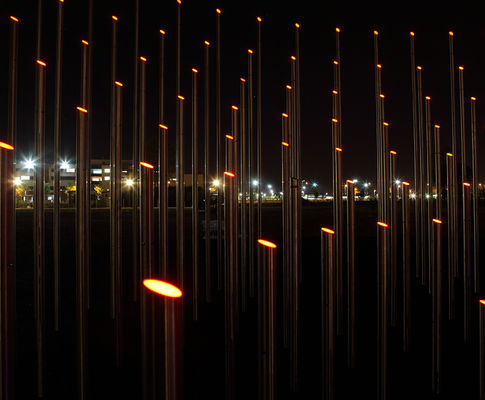top of page
credits
Lux Aeterna is a collaboration with the French artist Gilles Conan
history
the ceremonies are the 21 of September
abstract
The memorial is located on the backside of the former industrial area, at the precise location of the exploded AZF plant. From the entrance, the cylindrical volume appears closed due to the perspective effect of the offset poles. While approaching the memorial, moiré effects occur, and the volume gradually opens to the visitor’s vision. The poles are cut to different heights and angles, becoming shorter and more horizontal as they progress towards the center of the volume. As a result, a visitor who enters the memorial has a feeling of increasing openness, as if he would be at the center of a crater.
text
sound:
During daytime, each pole emits a sound, a note that is part of a predetermined harmony. These harmonies change over time. The three to five notes constituting one of these harmonies are randomly distributed over the field of poles. Their rapid change in position and quantity results in spatial sound effects and notes taking dominance above others, causing interference and beat tones, in between the other sounds. The transition from one sound to another is done by glissando, adding further disturbance to the sound field. The very low sounds are amplified by the resonance of the poles, depending on their length, and the sum of the 397 speakers, creating a space with blurred boundaries, offering ’isolation‘ in a noisy environment.
light:
At night, the poles light up white or red. Geometric and random illumination patterns succeed each other. The device’s capacity for the dimming of lights, allows light to change in a very soft or very rough manner, creating afterglow effects and disturbances in the spectator’s vision. Sound and light create an immaterial space while offering a physical and immersive experience. This relation between the immaterial and physical is further formalised by the poles which give the impression of a solid, but is paradoxically penetrable. Rather than being a literal representation of symbolic interpretation, the memorial is a ‘particular’ spatial experience shaped by visual and sound perception, an open field of interpretations.
public artworks by the Belgian artstudio LAb[au], laboratory for art and urbanism, atr&language, art&architecture crossing conceptual art, kinetic art, digital art, konkrete
bottom of page



![Lux æterna, memorial AZF, LAb[au]](https://static.wixstatic.com/media/fb1d51_5193025486dd43a9a6e28cc071a98962~mv2.jpg/v1/fit/w_485,h_400,q_90,enc_avif,quality_auto/fb1d51_5193025486dd43a9a6e28cc071a98962~mv2.jpg)
![Lux æterna, memorial AZF, LAb[au]](https://static.wixstatic.com/media/fb1d51_489b2d4e7cd34285b6e70ba19a65be88~mv2.jpg/v1/fit/w_485,h_400,q_90,enc_avif,quality_auto/fb1d51_489b2d4e7cd34285b6e70ba19a65be88~mv2.jpg)
![Lux æterna, memorial AZF, LAb[au]](https://static.wixstatic.com/media/fb1d51_46d35ca78c6d4aaf9f631ff4b2acf635~mv2.jpg/v1/fit/w_485,h_400,q_90,enc_avif,quality_auto/fb1d51_46d35ca78c6d4aaf9f631ff4b2acf635~mv2.jpg)
![Lux æterna, memorial AZF, LAb[au]](https://static.wixstatic.com/media/fb1d51_a1759c181ee3456c9793711ec60349f1~mv2.jpg/v1/fit/w_485,h_400,q_90,enc_avif,quality_auto/fb1d51_a1759c181ee3456c9793711ec60349f1~mv2.jpg)



![Lux æterna, memorial AZF, LAb[au]](https://static.wixstatic.com/media/fb1d51_b4adc02aad8c449388a4c77372cc790b~mv2.jpg/v1/fit/w_485,h_400,q_90,enc_avif,quality_auto/fb1d51_b4adc02aad8c449388a4c77372cc790b~mv2.jpg)


























